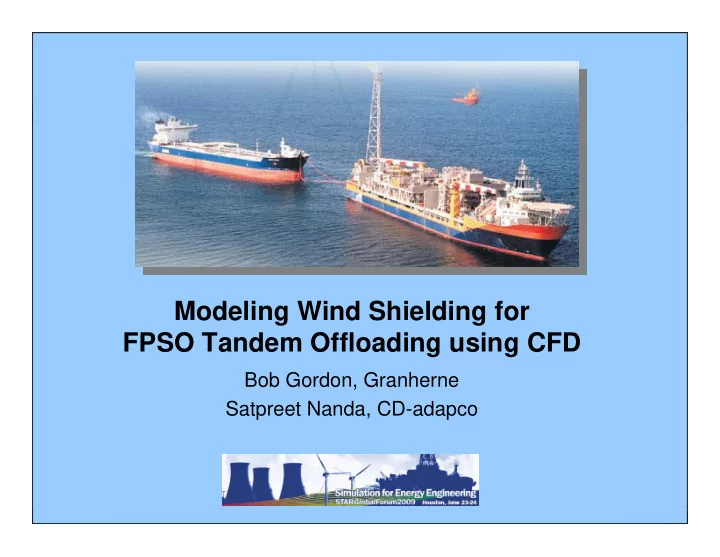

Modeling Wind Shielding for FPSO Tandem Offloading using CFD Bob Gordon, Granherne Satpreet Nanda, CD-adapco
Presentation Outline • FPSO Tandem Offloading • Examples of Shielding in Offshore Applications • Wind Tunnel Tests for Tandem Offloading • Preliminary CFD Results • Summary 2
FPSO Tandem Offloading • FPSO can be spread or turret moored – If turret moored, FPS orients into wind, wave and current • Tanker approaches under its own power and moors (with work boat assistance) to FPSO using hawsers • FPSO & Tanker are in close proximity during offloading and both Turret Moored change draft FPSO 3
Effects of Shielding • FPSO shields tanker from environment – Impacts tanker’s maneuverability during approach – Impacts separation distance while connected • Relative headings of the vessels can vary significantly during offloading due to shielding, Spread Moored FPSO effects of current, or fish-tailing 4
Collisions and Near Misses During Tandem Offloading in North Sea 1996-2000 Source: UK HSE Offshore Technology Report 2000/086 5
Examples of Shielding in Offshore Applications Multiple Riser Towers Grouped Single Line Risers Truss Spar Platform 6
Velocity Reduction due to Shielding 7 From van Walree and Willemsen, 1988
Wind Tunnel Tests • Part of MARIN’s Offloading Operability JIP • Tests performed at DNW in 2003 • Model scale was 1:250 • Barge-shaped FPSO model and shuttle tanker • Measurement of unshielded wind and current forces • Measurement of wind velocities behind the FPSO • Measurement of shielded forces for validation of shielding model 8
Use of CFD to Model Wind Tunnel Tests • Collaborative effort between MARIN, Granherne/KBR and CD-adapco • Surface geometry models prepared by MARIN • MARIN using in-house code and Granherne using STAR-CCM+ • Granherne calculations performed in the blind • Comparisons will be made against model test data and between CFD codes • Goal is to present joint paper at OMAE 2010 9
Vessel Characteristics 10 450 m
Position of Vessels Relative to Incident Wind & Velocity Profile Wind Velocity Profile Z/Z10 V/V10 11
Surface Mesh 12
Volume Mesh 13 SST k-omega turbulence 1.44 Million Cells y+ wall treatment model
Speed Contours in Horizontal Plane B Z=5m A A Z=30m A A B 14
Speed Contours in Vertical Plane A A B B 15
Streamlines 16
Pressure Contour 17
Drag and Lift on Tanker LIFT DRAG Tandem Arrangement (450 m separation) Shuttle Tanker Only Wind Tunnel Measurement OCIMF 18
Summary • Tandem offloading operations are sensitive to weather conditions • Accurate simulation of tandem offloading is difficult due to wind shielding • Wind loads on the shuttle tanker vary with relative wind direction, distance from FPSO and orientation relative to FPSO • Wind tunnel testing is limited due to relatively small number of configurations that can be tested • Preliminary CFD results indicate good agreement with wind tunnel data (but little shielding for case investigated) • CFD can provide a suitable means to augment wind tunnel test data 19
Acknowledgement • Thanks to Dr. Arjen Koop of MARIN for collaborating in this endeavor and for providing the vessel geometry models 20
Recommend
More recommend